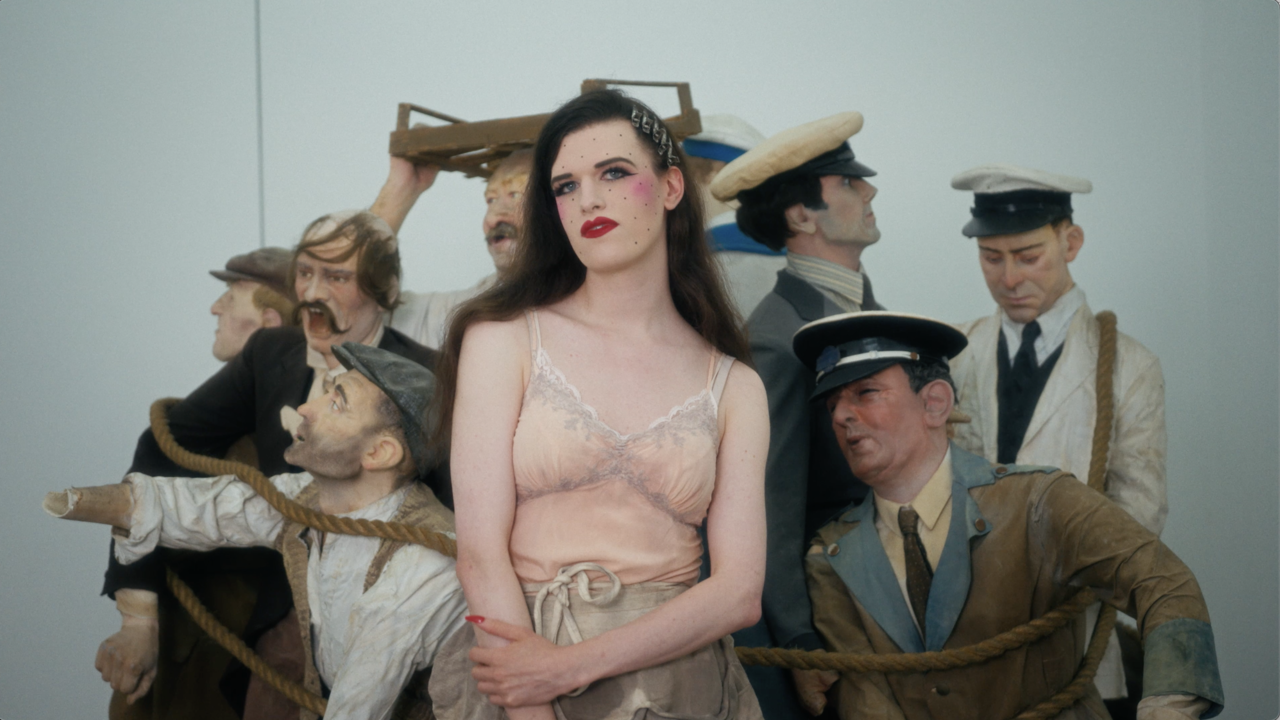Natascha Sadr Haghighian
Institutional critique and collective authorship; money, fruit and Robbie Williams
Institutional critique and collective authorship; money, fruit and Robbie Williams

A text like this usually starts with some biographical details about the artist. Rather than provide any straightforward biographical information, however, Natascha Sadr Haghighian directs curious viewers to a website she has founded, where ‘artists and other cultural practitioners can borrow, exchange and compile CVs for various purposes’. From the outset the artist confronts us with a consideration of identity and authorship, which extends to a reflection on social institutions and structures of power and representation. Deconstructive in approach, her work is often based on intensive research and investigation employing archive material, interviews and field trips, and she tends to present her installations – which comprise video, sound, slide projections, computer software or other technological devices – in a rather dry and clinical way. However, despite their rigour, Sadr Haghighian’s works reveal a subtle, sometimes self-deprecating sense of humour, which derives from her frustration at the limitations she experiences both as an artist and in the contexts she decides to explore.
The recent exhibition at Frankfurter Kunstverein (‘Fruit of One’s Labour’, 2008) is an ironic speculation on money: Frankfurt is Germany’s financial centre and home to the European Central Bank, responsible for monetary policy in the Eurozone. In the show, briquettes of shredded bank notes are piled up next to an old oven, the absurdly intricate piping of which extends through a glass partition blocking the entrance to the second gallery space; not smoke but apples emanate from the piping, lit by disco lights to the sound of muted techno, yet in the context of the current credit crisis and disillusionment with the Euro, the party is obviously over.
Earlier works, such as the video Point of View – On Art in Hospitals (1998–2001) – a collaboration with Michael Guggenheim examining patients’ reactions to the art works hung in their rooms – are short, Foucaultian essays on the social paradigms at play in architecture and urban environments. But it is the institutional and commercial systems of the art world that have become the predominant subjects of Sadr Haghighian’s investigations. Unternehmen: Bermuda (Enterprise: Bermuda, 2000) was the artist’s contribution to the Federation of German Industries’ Ars Viva prize. It consisted of her meeting with the judges at a bus stop in Berlin and, like spies in a B-movie, exchanging slides kept in a metal briefcase, in a sort of group performance. A similarly direct confrontation can be found in Present but not yet Active (2002), shown at Manifesta 4 in Frankfurt, in which the artist reversed the usual process of curatorial selection by organizing a meeting at the local zoo with the biennial’s three curators. They were filmed from several perspectives, in the spirit of a wildlife documentary, turning them, rather than the artist they had chosen to participate, into objects of scrutiny and display.
In some works, Haghighian’s frustration at the limitations of the artistic context can rise to the level of tense anxiety. In her installation Die Krankheiten des Uhus und ihre Bedeutung für die Wiedereinbürgerung in der Bundesrepublik Deutschland (The Illnesses of the Eagle Owl and their Significance for its Repatriation in the Federal Republic of Germany, 2003), each visitor entering the gallery triggers a digital audio system to play the recording of an increasingly panic-stricken bird fluttering through the space. As more people enter the room, more tracks start up, increasing the cacophony; as each person leaves, a track stops, until eventually silence falls. In another piece, the most basic elements used to hang art – nails – are hammered into the wall of an art-fair gallery booth in such a way that they form the outline of the polemical sentence, I Can’t Work Like This (2007).
‘Solo Show’, recently held at MAMbo in Bologna, took the anxiety about the artist’s conditions to an ambitious extreme. A collaboration with mixedmedia berlin – a behind-the-scenes production company that realizes art works for well-known artists – the exhibition was divided into two parts. The first consisted of a ‘solo show’ by the fictional artist Robbie Williams. Employing materials and objects that are part of the company’s production chain, the sculptural works on display resembled show-jumping fences and looked like weird, hybrid mock-ups for pieces the company has created for artists such as John Armleder, Monica Bonvicini and Liam Gillick. The second part consisted of a sound installation in which different speakers broadcast a recording of a galloping horse. Everyone involved in the realization of the show was listed as one of the collective ‘authors’, while its accompanying catalogue delved deeper into the implied questions of authorship and production. By reading the different contributions in sequence – from the artist’s foreword to the curator’s afterword – the fictional identity of the artist Robbie Williams is slowly revealed and the entire project unfolds its narrative potential. It seems institutional critique can be a story well told, too.






















